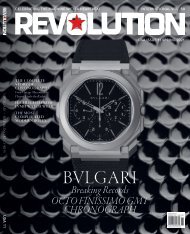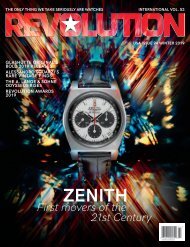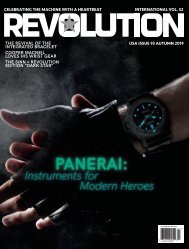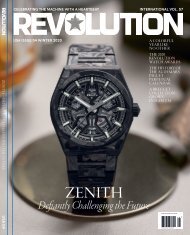You also want an ePaper? Increase the reach of your titles
YUMPU automatically turns print PDFs into web optimized ePapers that Google loves.
THE CARRERA, 1964 (LEFT) VS 2020 (RIGHT)<br />
5 KEY DIFFERENCES<br />
1964 REF. 2447S<br />
The 2447S is housed in<br />
a 36mm stainless steel<br />
case, which is rather<br />
large for the era.<br />
It’s fitted with a boxed<br />
acrylic crystal.<br />
The watch bears a<br />
manually wound Valjoux<br />
72 movement.<br />
The running seconds<br />
for the watch is situated<br />
at nine o’clock, based<br />
on the configuration<br />
of the Valjoux 72.<br />
Within the 12-hour totalizer,<br />
the dial has a ‘T’ marking<br />
above the ‘SWISS’ label,<br />
indicating the use of tritium<br />
as luminous material.<br />
2020 CARRERA 160<br />
YEARS SILVER EDITI<br />
The watch is housed in a<br />
39mm stainless steel cas<br />
a suitable contemporary<br />
dress size for 2020.<br />
It’s fitted with a boxed<br />
sapphire crystal.<br />
The watch bears a<br />
self-winding Heuer 02<br />
in-house movement,<br />
which has been tested<br />
extensively for precision.<br />
The running seconds<br />
for the watch is situated<br />
at six o’clock.<br />
The ‘SWISS’ label is loca<br />
within the running seco<br />
withoutthe‘T’marking,<br />
following the 1963 dial<br />
execution of the 2447S.<br />
degree of water resistance. I decided to use the inside<br />
bevel of this tension ring to carry the markings measuring<br />
one-fifths of a second. In other words, the flat dial surface<br />
no longer had to carry these markings — they had now been<br />
shifted off onto the tension ring — and this was the secret<br />
behind the fresh, clean and uncluttered appearance of my<br />
first ‘Carrera’.”<br />
CELEBRATING A MILESTONE<br />
The Carrera marked its 50th anniversary back in 2013, but<br />
there’s been a renewed sense of interest in the watch and<br />
its lineage, as evident in recent runaway successes such as<br />
the TAG Heuer Carrera Fragment, created in collaboration<br />
with acclaimed Japanese artist, Hiroshi Fujiwara.<br />
The strength in the present-generation Carreras<br />
stems from the design identity that Jack Heuer himself<br />
established when he launched the watch collection in<br />
1963; i.e. its “fresh, clean and uncluttered” dial.<br />
In celebrating the milestone that the Carrera was for<br />
both Jack Heuer and Heuer, the company, TAG Heuer in<br />
2020 is dedicating its 160th anniversary year, to the Carrera.<br />
And celebrations are already underway, with the TAG Heuer<br />
Carrera 160 Years Silver Limited Edition that was stealthily<br />
launched during the LVMH Watch Week in Dubai.<br />
Stealthily because, TAG Heuer wasn’t formally<br />
exhibiting in Dubai. We got to hear of the watch as a<br />
result of a miscommunication (with the watch appearing<br />
on Instagram ahead of its official launch) and the<br />
kindness of our friend, and TAG Heuer’s heritage<br />
director, Catherine Eberle-Devaux, who was casually<br />
present at the fair with the watch in her pocket.<br />
Catherine shared with us that the watch created to kick<br />
the year off is based off a 1964 Carrera, referred to as the<br />
2447S. The 2447 is believed to have been one of the earliest<br />
Carreras, with the very first examples of it to have left the<br />
manufacture in 1963, fitted with a matte eggshell-white<br />
dial. These are some of the rarest specimens of the 2447S.<br />
In the following year, the watch was fitted with a silver<br />
starburst-finished dial and these remained in production<br />
for the longer lifespan of the watch. It is suggested that the<br />
reason that Heuer and Singer, the dial producer, had moved<br />
away from the eggshell-colored dials is possibly that the<br />
treatment on the dials proved too fragile for heavy use.<br />
Jack mentions in his autobiography that he decided<br />
to use the inside bevel of the steel tension ring that fitted<br />
inside the crystal, and kept it under tension against the<br />
surrounding steel case, to carry the markings measuring<br />
one-fifths of a second. But later as demand for variations of<br />
chronograph scales grew among Heuer customers, parts of<br />
the scale had to be brought back to the primary dial.<br />
These later dials can also be identified by the “T” above<br />
the “SWISS” print in the six o’clock counter. Aesthetic<br />
differences aside, all of these watches were driven by the<br />
Valjoux 72, which lent to the 36mm diameter of the watch;<br />
the 30-minute totalizer (three o’clock); 12-hour totalizer<br />
(six o’clock); and the running small seconds (nine o’clock).<br />
90 THE MODERNIST











